高考英语阅读理解细节题的解题技巧
- 格式:docx
- 大小:13.60 KB
- 文档页数:4
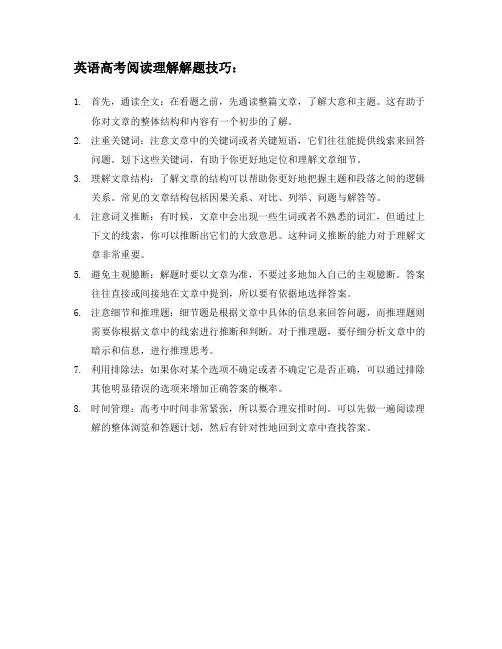
英语高考阅读理解解题技巧:
1.首先,通读全文:在看题之前,先通读整篇文章,了解大意和主题。
这有助于
你对文章的整体结构和内容有一个初步的了解。
2.注重关键词:注意文章中的关键词或者关键短语,它们往往能提供线索来回答
问题。
划下这些关键词,有助于你更好地定位和理解文章细节。
3.理解文章结构:了解文章的结构可以帮助你更好地把握主题和段落之间的逻辑
关系。
常见的文章结构包括因果关系、对比、列举、问题与解答等。
4.注意词义推断:有时候,文章中会出现一些生词或者不熟悉的词汇,但通过上
下文的线索,你可以推断出它们的大致意思。
这种词义推断的能力对于理解文章非常重要。
5.避免主观臆断:解题时要以文章为准,不要过多地加入自己的主观臆断。
答案
往往直接或间接地在文章中提到,所以要有依据地选择答案。
6.注意细节和推理题:细节题是根据文章中具体的信息来回答问题,而推理题则
需要你根据文章中的线索进行推断和判断。
对于推理题,要仔细分析文章中的暗示和信息,进行推理思考。
7.利用排除法:如果你对某个选项不确定或者不确定它是否正确,可以通过排除
其他明显错误的选项来增加正确答案的概率。
8.时间管理:高考中时间非常紧张,所以要合理安排时间。
可以先做一遍阅读理
解的整体浏览和答题计划,然后有针对性地回到文章中查找答案。
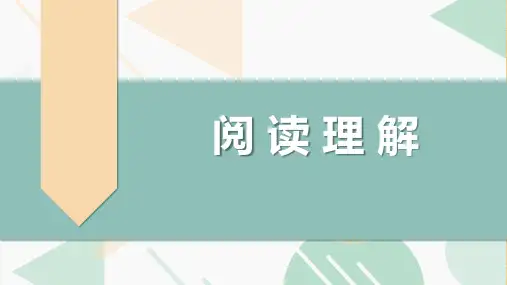
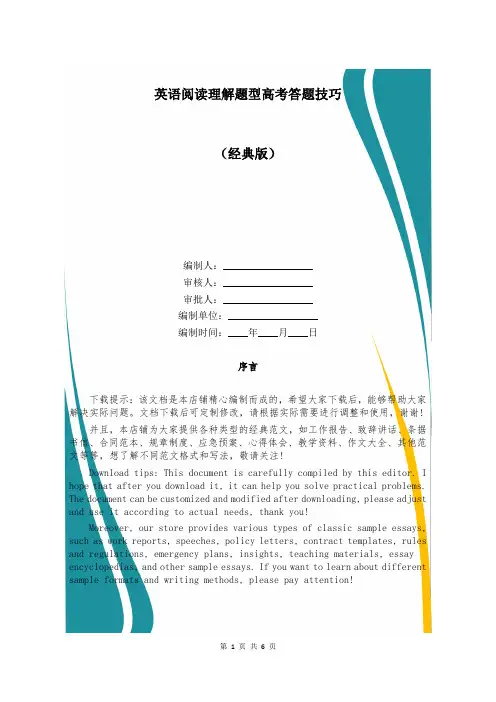
英语阅读理解题型高考答题技巧(经典版)编制人:__________________审核人:__________________审批人:__________________编制单位:__________________编制时间:____年____月____日序言下载提示:该文档是本店铺精心编制而成的,希望大家下载后,能够帮助大家解决实际问题。
文档下载后可定制修改,请根据实际需要进行调整和使用,谢谢!并且,本店铺为大家提供各种类型的经典范文,如工作报告、致辞讲话、条据书信、合同范本、规章制度、应急预案、心得体会、教学资料、作文大全、其他范文等等,想了解不同范文格式和写法,敬请关注!Download tips: This document is carefully compiled by this editor. I hope that after you download it, it can help you solve practical problems. The document can be customized and modified after downloading, please adjust and use it according to actual needs, thank you!Moreover, our store provides various types of classic sample essays, such as work reports, speeches, policy letters, contract templates, rules and regulations, emergency plans, insights, teaching materials, essay encyclopedias, and other sample essays. If you want to learn about different sample formats and writing methods, please pay attention!英语阅读理解题型高考答题技巧英语阅读理解题型高考答题技巧分享阅读理解题型是高考英语占分值比较大的一个题型,运用哪些答题技巧可以轻松作答阅读理解题呢?下面是本店铺为大家整理的关于英语阅读理解题型高考答题技巧,欢迎大家来阅读。
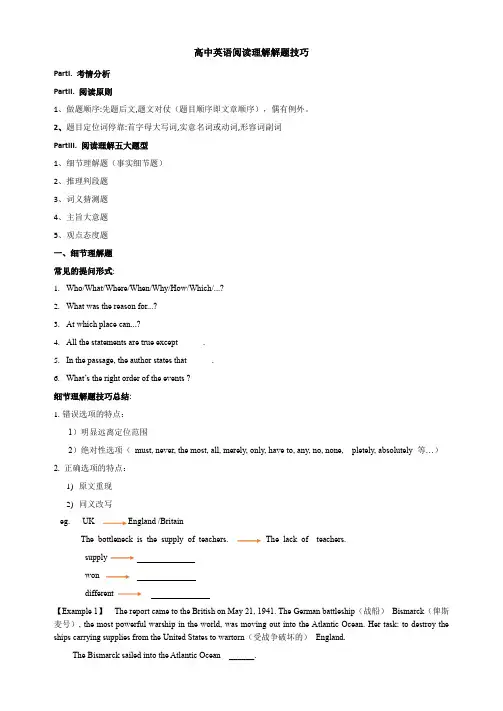
高中英语阅读理解解题技巧PartI. 考情分析PartII. 阅读原则1、做题顺序:先题后文,题文对仗(题目顺序即文章顺序),偶有例外。
2、题目定位词停靠:首字母大写词,实意名词或动词,形容词副词PartIII. 阅读理解五大题型1、细节理解题(事实细节题)2、推理判段题3、词义猜测题4、主旨大意题5、观点态度题一、细节理解题常见的提问形式:1.Who/What/Where/When/Why/How/Which/...?2.What was the reason for...?3.At which place can...?4.All the statements are true except.5.In the passage, the author states that.6.What’s the right order of the events ?细节理解题技巧总结:1.错误选项的特点:1)明显远离定位范围2)绝对性选项(must, never, the most, all, merely, only, have to, any, no, none, pletely, absolutely 等…)2. 正确选项的特点:1)原文重现2)同义改写eg. UK England /BritainThe bottleneck is the supply of teachers. The lack of teachers.supplywondifferent【Example 1】The report came to the British on May 21, 1941. The German battleship(战船)Bismarck(俾斯麦号), the most powerful warship in the world, was moving out into the Atlantic Ocean. Her task: to destroy the ships carrying supplies from the United States to wartorn(受战争破坏的)England.The Bismarck sailed into the Atlantic Ocean ______.A. to sink the Hood(胡德号战舰)B. to gain control of FranceC. to cut off American supplies to BritainD. to stop British warships reaching Germany【Example 2】The report came to the British on May 21, 1941. The German battleship(战船)Bismarck(俾斯麦号), the most powerful warship in the world, was moving out into the Atlantic Ocean. Her task: to destroy the ships carrying supplies from the United States to wartorn(受战争破坏的)England.The British had feared such a task. No warships(战船)they had could match the Bismark(俾斯麦号)in speed or in firepower(火力). The Bismarck had eight 15inch guns(火炮)and 81 smaller guns. She could move at 30 nautical miles (海里) an hour. She was believed to be unsinkable(不沉的).Many people believed that the Bismarck was the most strongest one because she ______.A. was fast and powerfulB. had more men on boardC. was under Luetjens’ mandD. had bigger guns than other ships牛刀小试:【EX. 1】However, the British had to sink her. They force their best battleship Hood(胡德号战舰)to hunt down the Bismarck(俾斯麦号). On May 24, the Hood found the Bismarck.It was a meeting(会面)that the German mander(指挥官)did not want to see. His orders were to destroy the British ships that were carrying supplies, but to stay away from a fight with British warships.The battle didn’t last long. The Bismarck’s first torpedo (鱼雷) hit the Hood, which went down taking all but three of her 1, 419 men with her.We learn from the text that on 24 May ______.A. the British won the battle against the BismarckB. the Bismarck won the battle against the BritishC. the British gunfire damaged the Bismarck seriouslyD. the Bismarck succeeded in keeping away from the British【EX. 2】But in the fight, the Bismarck was slightly damaged . Her mander decided to run for repairs to France, which had at that time been taken by the Germans. The British force followed her. However, because of the Bismarck’s speed and the heavy fog, they lost sight of her.Her mander tried to sail(航行)to France in order to ______.A. have the ship repairedB. join the other GermansC. get help from the FrenchD. get away from the British二、推理判断题常见提问方式1.The passage implies (暗示) that_______.2.We can conclude (得出结论) from the passage that_____.3.Which of the following can be inferred (推论)?4.What is the tone (语气) of the author ?5.What is the purpose (目的) of this passage?6.The passage is intended to (倾向于) _____.7.Where would this passage most probably appear(出现)?8.The next paragraph would most probably deal with_______.9.At the end of this passage, the writer might continue to write _______.技巧点拨:1.推断隐含意义【Example 1】A buildityourself solar still(自制太阳能蒸馏器)is one of the best ways to obtain drinking water in areas where the liquid is not readily available…..The only ponents(成分)required, though, are a 5' ×5' sheet of clear(透明的)or slightly milky(略带乳白色的)plastic, six feet of plastic tube(试管), and a container(容器)—perhaps just a drinking cup —to catch the water. These pieces can be folded(折叠)into a neat little pack and fastened(系)on your belt(腰带).1.What do we know about the solar still (蒸馏器)from the first paragraph? ()A. It’s delicate(精致的).B. It’s expensive.C. It’s plex.D. It’s portable(便携的).推断隐含意义题技巧总结:①Scanning,找到相关信息点②Study reading,不但理解表层,而且要由表及里、由浅入深地分析③推理,以文中提供的信息为依据,结合常识,作出符合逻辑的推断2.推断写作目的【Example 1】It’s an amazing acplishment(成就)and one we cannot achieve without generous support from individuals, corporations(企业), and other social organizations(组织). Visit to find various ways you can support Pacific Science Center.1.What is the purpose of the last part of the text? ()A. To encourage supports.B. To advertise ing events.C. To introduce special exhibits.D. To tell about the Center’s history.推断写作目的题技巧总结1:找句来推断写作目的。

英语阅读理解细节题的解题技巧一、语义转换题——跳读查找法这是做事实细节题最基本也是最常用的方法。
在通常情况下,细节题主要考查考生对某句话或某几句话的理解,同学们若能根据题干内容从原文中找到相关的句子,然后进行比较和分析,便可确定最佳答案。
运用跳读查找法时,同学们要特别注意试题(包括选项)与原文之间的适当变换。
根据近几年的考题情况来看,现在很少有直接用原文中的句子进行考查和测试的,而通常要进行一定的处理。
而这种“处理”主要就是指进行语义转换,其中包括同义变换、概念解析、归纳事实等。
请看下面的例子(重庆高考英语试题):“My kids really understand solar and earth-heat energy,” says a second-grade teacher in Saugus,California.“Some of them are building solar collectors for their energy course.” These young scientists are part of City Building Educational Program(CBEP),a particular program for kindergarten through twelfth grade that uses the stages of city planning to teach basic reading,writing and math skills,and more.The children dont just plan any city. They map and analyze(分析) the housing,energy,and transportation requirements of their own district and foretell its needs in 100 years. With the aid of an architect(建筑师) who visits the classroom once a week,they invent new ways to meet these needs and build models of their creations.“Designing buildings of the future gives children a lot of freedom,”says the teacher who developed this program.“They are able to use their own rich imagination and inventions without fear of blame,because there are no wrong answers ina future context. In fact,as the class enters the final model-building stage of the program,an elected official and planning group make all the design decisions for the model city,and the teacher steps back and becomes an adviser.”CBEP is a set of activities,games and imitations that teach the basic steps necessary for problem-solving:observing,analyzing,working out possible answers,and judging them based on the childrens own standards.1. An architect pays a weekly visit to the classroom________ .A. to find out kids creative ideasB. to discuss with the teacherC. to give children lecturesD. to help kids with their program2. Who is the designer of the program?A. An official.B. An architect.C. A teacher.D. A scientist.【解题分析】1.选 D。
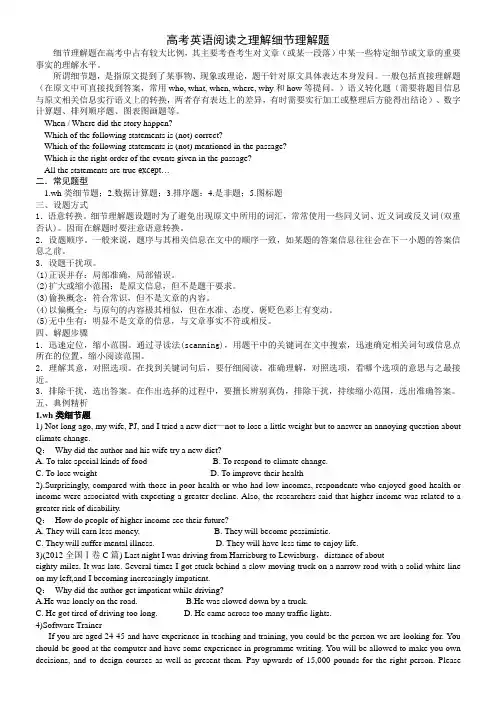
高考英语阅读之理解细节理解题细节理解题在高考中占有较大比例,其主要考查考生对文章(或某一段落)中某一些特定细节或文章的重要事实的理解水平。
所谓细节题,是指原文提到了某事物、现象或理论,题干针对原文具体表达本身发问。
一般包括直接理解题(在原文中可直接找到答案,常用who, what, when, where, why和how等提问。
)语义转化题(需要将题目信息与原文相关信息实行语义上的转换,两者存有表达上的差异,有时需要实行加工或整理后方能得出结论)、数字计算题、排列顺序题、图表图画题等。
When / Where did the story happen?Which of the following statements is (not) correct?Which of the following statements is (not) mentioned in the passage?Which is the right order of the events given in the passage?All the statements are true except…二.常见题型1.wh类细节题;2.数据计算题;3.排序题;4.是非题;5.图标题三、设题方式1.语意转换。
细节理解题设题时为了避免出现原文中所用的词汇,常常使用一些同义词、近义词或反义词(双重否认)。
因而在解题时要注意语意转换。
2.设题顺序。
一般来说,题序与其相关信息在文中的顺序一致,如某题的答案信息往往会在下一小题的答案信息之前。
3.设题干扰项。
(1)正误并存:局部准确,局部错误。
(2)扩大或缩小范围:是原文信息,但不是题干要求。
(3)偷换概念:符合常识,但不是文章的内容。
(4)以偏概全:与原句的内容极其相似,但在水准、态度、褒贬色彩上有变动。
(5)无中生有:明显不是文章的信息,与文章事实不符或相反。
四、解题步骤1.迅速定位,缩小范围。
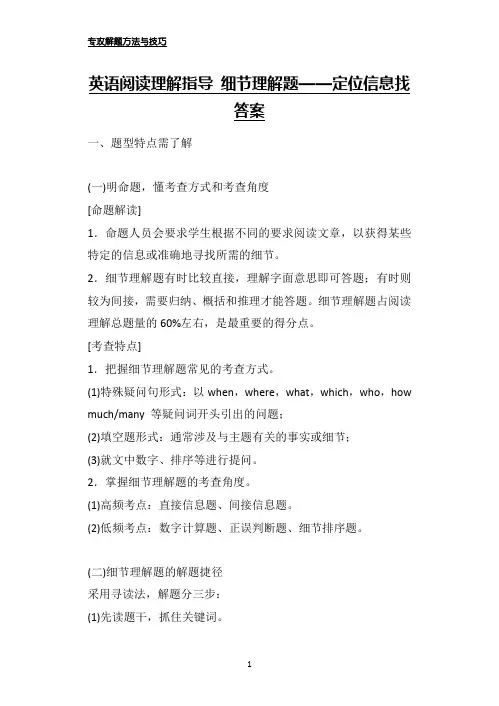
英语阅读理解指导细节理解题——定位信息找答案一、题型特点需了解(一)明命题,懂考查方式和考查角度[命题解读]1.命题人员会要求学生根据不同的要求阅读文章,以获得某些特定的信息或准确地寻找所需的细节。
2.细节理解题有时比较直接,理解字面意思即可答题;有时则较为间接,需要归纳、概括和推理才能答题。
细节理解题占阅读理解总题量的60%左右,是最重要的得分点。
[考查特点]1.把握细节理解题常见的考查方式。
(1)特殊疑问句形式:以when,where,what,which,who,how much/many 等疑问词开头引出的问题;(2)填空题形式:通常涉及与主题有关的事实或细节;(3)就文中数字、排序等进行提问。
2.掌握细节理解题的考查角度。
(1)高频考点:直接信息题、间接信息题。
(2)低频考点:数字计算题、正误判断题、细节排序题。
(二)细节理解题的解题捷径采用寻读法,解题分三步:(1)先读题干,抓住关键词。
(2)带着问题快速阅读文章,找出与问题有关的词语或句子。
(3)仔细对比选项和原文信息,继而找出答案。
(三)细节理解题的正确选项特征同义替换①指对原文句子中的关键词进行同义替换,如把lose one's job换成be out of work。
②有些细节理解题把原文中的一些词变换一下词性,如把important变换成of importance。
③改变原文中句子的语态,如主动语态与被动语态的转换信息归纳用精炼的语言来概括原文中比较分散或复杂的信息,设置为正确答案正话反说把原文中的意思反过来表达而成为正确选项原文原词利用原文原词作为正确选项(四)细节理解题的干扰选项特征张冠李戴是原文信息,但不是题目要求的内容无中生有符合常识,但不是文章的内容曲解文意与原文的内容极其相似,只是在某个细节处有些变动颠倒是非在意思上与原文大相径庭,甚至完全相反正误参半部分正确,部分错误二、方法技巧要知晓题型一直接信息题在解答直接信息题时,可以采取“关键词定位法”,即“带着问题找答案”的方法,通过定位找题眼[典例](2022·全国乙卷)Admission£4.Children under 12 years accompanied by an adult are admitted free.22.How much would a couple with two children under 12 pay for admission?A.£4.B.£8.C.£12.D.£16. [解析]本题是直接信息题。

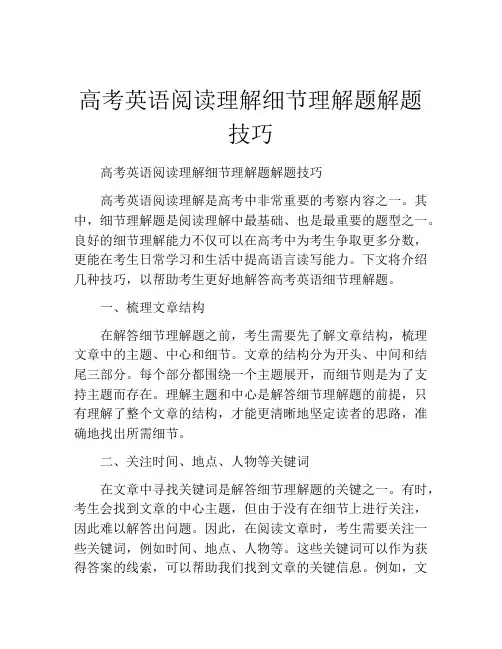
高考英语阅读理解细节理解题解题技巧高考英语阅读理解细节理解题解题技巧高考英语阅读理解是高考中非常重要的考察内容之一。
其中,细节理解题是阅读理解中最基础、也是最重要的题型之一。
良好的细节理解能力不仅可以在高考中为考生争取更多分数,更能在考生日常学习和生活中提高语言读写能力。
下文将介绍几种技巧,以帮助考生更好地解答高考英语细节理解题。
一、梳理文章结构在解答细节理解题之前,考生需要先了解文章结构,梳理文章中的主题、中心和细节。
文章的结构分为开头、中间和结尾三部分。
每个部分都围绕一个主题展开,而细节则是为了支持主题而存在。
理解主题和中心是解答细节理解题的前提,只有理解了整个文章的结构,才能更清晰地坚定读者的思路,准确地找出所需细节。
二、关注时间、地点、人物等关键词在文章中寻找关键词是解答细节理解题的关键之一。
有时,考生会找到文章的中心主题,但由于没有在细节上进行关注,因此难以解答出问题。
因此,在阅读文章时,考生需要关注一些关键词,例如时间、地点、人物等。
这些关键词可以作为获得答案的线索,可以帮助我们找到文章的关键信息。
例如,文章中有“在冬天”、“在下午”这些关键词汇,我们可以通过这些关键词来确定文章中的时间和情境背景。
三、仔细识别特定词汇阅读理解中经常会有一些特定词汇,例如数字、描述性句子、比喻、引用等等。
这些特定词汇会提供更多有用的信息,这些信息在解答细节理解题时非常重要。
例如,数字通常与事件或数量有关,描述性句子常常与具体物品或事件相关等。
仔细识别特定词汇可以让我们更加深入地理解文章,也更容易找到我们需要的细节。
四、对上下文的关系进行思考理解文章的上下文关系是解答细节理解题的关键之一。
学生很容易在一句话或一个解释中找到答案,但未能掌握上下文的重要性。
如果一句话与上下文相反,那么这句话就不能成为答案的依据。
因此,当我们阅读文章时,不能孤立地解读某一句话,而应该把它放在上下文中进行分析和理解,以便更好地找出细节和答案。
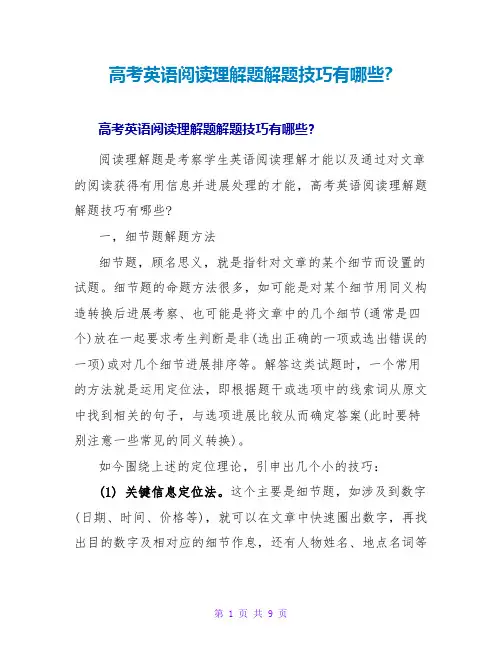
高考英语阅读理解题解题技巧有哪些?高考英语阅读理解题解题技巧有哪些?阅读理解题是考察学生英语阅读理解才能以及通过对文章的阅读获得有用信息并进展处理的才能,高考英语阅读理解题解题技巧有哪些?一,细节题解题方法细节题,顾名思义,就是指针对文章的某个细节而设置的试题。
细节题的命题方法很多,如可能是对某个细节用同义构造转换后进展考察、也可能是将文章中的几个细节(通常是四个)放在一起要求考生判断是非(选出正确的一项或选出错误的一项)或对几个细节进展排序等。
解答这类试题时,一个常用的方法就是运用定位法,即根据题干或选项中的线索词从原文中找到相关的句子,与选项进展比较从而确定答案(此时要特别注意一些常见的同义转换)。
如今围绕上述的定位理论,引申出几个小的技巧:(1) 关键信息定位法。
这个主要是细节题,如涉及到数字(日期、时间、价格等),就可以在文章中快速圈出数字,再找出目的数字及相对应的细节作息,还有人物姓名、地点名词等等,其他的还包括一些提示情节开展,或条纲性关键字眼,如First, Next, Finally等等。
As a young girl growing up in the 1930s, I always wanted to fly a plane, but back then it was almost unheard of for a woman to do that. I got a taste of that dream in 2023,when my husband arranged for me to ride in a hot air balloon for my birthday. (2023年高考英语北京A篇)What happened to the author in 2023?A. She flew an airplaneB. She entered a petitionC. She went on a hot air balloon rideD. She moved into a retirement munity解析:此题属典型细节题,通过题干中的时间in 2023不难定位到文中粗体字部分,很容易可以锁定正解为C。

一、高考英语细节题考察概况:1.宏观考察概况:细节理解题有时比较直接,理解字面意思即可答题;有时则较为间接,需要归纳、概括和推理才能答题。
细节理解题占阅读理解总题量的60%左右,是最重要的得分点。
2.微观考察概况:(1)设问方式特殊疑问句形式:以when、where、what、which、who、why、how等疑问词开头引出的问题;通常涉及与主题有关的事实或细节,或就文中的数字进行提问。
(2)考察规律①正确选项特征A.同义替换(原句重复出现,200%错。
正确的都是有改动的,即同义替换。
)(1)替换关键词。
把原文的关键词进行同义替换,如把lose one's job换成了be out of occupation(2)改变词性。
把原文中的一些词变换了一下词性,如把so much important变换成of importance(3)改变语态。
把原文主动语态转为被动语态,如restoring and repairing the bridge变换成the bridge was restoring and reparing.B.信息归纳用精炼的语言来概括原文中比较分散或复杂的信息; 正确答案具有概括性(考察考生的理解归纳能力),深刻性,因为其考查的对象是阅读文章的重点和要点。
C.正话反说把原文中的意思反过来表达而成为正确选项比如说:I constantly remained confused about the learning predicament.我一直对学习的困境感到困惑。
②干扰选项特征A.张冠李戴,无中生有B.曲解文意,答非所问C.颠倒是非,因果倒置,无原因推导(过度推断)D.正误参半,盲目推断,正反混淆二、高考英语阅读细节题三步法:第一步,初步读题干,弄清楚关键词所在位置和明确答题方向第二步,迅速定位和找出题干关键词相关的近义词,反义词或者解释性信息,最好明确句间逻辑关系和段间逻辑关系(因果,递进,解释,转折,对比,比较等关系)第三步,利用正确选项特点,确定答案(明确近义词替换原文信息,关注变换原文语态词性或词形,简化或概括原文,正话反说)三、高考英语阅读细节题三步法带练1.What do we know about Astro Access?A. It redesigns jet airplanes.B. It offers weightlessness experience.C. It provides physical treatmentD. It hires the disabled to be astronauts第一步,初步读题干,弄清楚关键词所在位置和明确答题方向1.What do we know about Astro Access?我们对星际通道了解多少?问的角度是什么what;对象是星际通道第二步,迅速定位和找出题干关键词相关的近义词,反义词或者解释性信息,最好明确句间逻辑关系和段间逻辑关系(因果,递进,解释,转折,对比,比较等关系)Mazyck was one of 12 participants in a Zero Gravity flight, organized by the group Astro Access. This type of flight recreates the weightlessness that astronauts experience without going all the way to space. Flying over the Pacific Ocean off Southern California, the modified 747 jet airplane made 15 steep dives and climbs, allowing the flyers multiple periods of weightlessness.The experience left Mazyck feeling joyful. “The flight was something that I would never have experienced in my wildest dreams," she says, “especially the floating the weightlessness.原词对应:weightlessness(失重;无重状态);experience(体验);由于这段话没有出现转折连接词,所以判断这个段落各个句子的逻辑关系是顺承关系段落翻译:Mazyck是由Astro Access组织的零重力飞行的12名参与者之一。
高考英语阅读理解细节理解题解题技巧一、语义转换题跳读查找法通常状况下,细节理解题主要考查考生对某句话或某几句话的理解,同学们假设能依据题干内容从原文中找到相关的句子,然后进行比较和分析,便可确定最正确答案。
运用跳读查找法时,同学们要特别注意试题(包括选项)与原文之间的适当变幻。
从近几年的高考题来看,很少有直接用原文中的句子进行考查和测试的,而通常要进行语义转换,其中包括同义变幻、概念解析、归纳事实等。
二、生活应用题常识理解法生活应用题要求考生在读懂文章的基础上结合一定的生活常识进行推断。
高考题有时也会出现这类题,运用一定的生活常识并结合文意即可选出最正确答案。
三、细节排序题首尾定位法这种试题要求考生依据事件发生的先后顺序和句子之间的逻辑关系,找出事件发生的正确顺序。
同学们在做这种题时可采纳"首尾定位法',即先找出第一个事件和最后一个事件,然后缩小选择范围,从而能快速选出正确答案。
四、寻找信息题题干定位法快速寻找信息题一般为功能阅读题,主要形式有广告、公告、演出信息、航班随时表等。
做这类题时没有必要阅读全文,宜采纳"题干定位法'。
依据题干中提供的信息,快速从原文中找到相应的信息。
2高考英语阅读理解解题攻略一、事实细节题关于事实细节题,剖析一下不难看出,事实细节的内容不会单独出现,它总会与前前后后的段落内容相呼应。
考生只要抓住整体大纲,看懂主题,利用内容间的因果关系,通过时间空间的关系转换,并对细节进行深入的剖析了理解,确定主题,将零碎的细节组成一个有机整体,就能深入理解材料的内容,从而轻松解决问题。
二、词句理解题词句理解题主要讲究的是理解题意,通过短文的词、短语或句子的理解来充分理解题意,,碰到不熟悉的词语要避过,先略读再通读,仔细推敲,尤其是对语境的理解要准确。
三、推理推断题推理推断题最主要的就是注重文章结构的逻辑关系,抓住关键词,结合有关的生活和社会常识,理清文章的结构层次、文章内容和文章的中心思想,推断的写作意图和写作目的,进行推断。
高考阅读理解题型与解题技巧阅读理解题是高考英语试卷中非常重要的一部分,它旨在测试学生对英语文章的理解能力、信息获取能力以及推理判断能力。
以下是一些常见的高考阅读理解题型及解题技巧:一、细节理解题细节理解题是高考阅读理解中最常见的一种题型,主要考查学生对文章中具体事实和细节的理解能力。
这种题型通常会以以下形式出现:1.根据文章内容,下列哪个选项是正确的?2.根据文章内容,可以得出以下哪个结论?3.下列选项中,与文章内容不符的是哪一项?解题技巧:1.定位法:先找到题目中的关键词或关键信息,然后在文章中寻找对应的位置,注意选项中的细节和原文的表述是否一致。
2.排除法:如果选项中出现了与原文不符的信息,那么这个选项就是错误的。
排除法可以帮助我们缩小选择范围,提高正确率。
二、推理判断题推理判断题是阅读理解中比较难的一种题型,它要求学生根据文章中的信息进行推理和判断,从而得出结论。
这种题型通常会以以下形式出现:1.根据文章内容,可以推断出以下哪个结论?2.文章中没有提到但是可以推断出来的是哪一项?3.根据文章内容,可以推断出作者的观点是什么?解题技巧:1.找到文章中的关键信息,尤其是转折词和表示因果关系的词。
例如:but、however、because等。
这些词可以帮助我们判断出作者的态度和意图。
2.注意文章中的细节描写和举例,这些细节和例子往往是为了支持作者的观点或论证某个结论。
因此,要学会从细节中寻找证据。
3.排除法同样适用于推理判断题。
如果选项中出现了与原文相反的观点或与作者意图不符的结论,那么这个选项就是错误的。
排除法可以帮助我们缩小选择范围,提高正确率。
三、主旨大意题主旨大意题是阅读理解中比较难的一种题型,它要求学生概括文章的主旨大意或中心思想。
这种题型通常会以以下形式出现:1.本文的中心思想是什么?2.下列哪个选项最能概括文章的主要内容?3.本文主要探讨了什么问题?解题技巧:1.找主题句:主题句通常出现在文章的开头或结尾,用来概括文章的主旨大意。
高考英语阅读理解细节题常见出题“陷阱”高考英语阅读理解题型中常见的题目设置包括主旨大意题、细节理解题、推理判断题和词义猜测题等四大题型。
细节理解题一直是考查重点,且该题型的难度逐年上升,但只要考生掌握了此种题型的命题特点和应对办法,再难的题目也会迎刃而解!一、直接信息题在高考英语阅读理解试题中,假如答题信息可以直接从文中获取,我们称之为直接信息题。
直接信息题常用特殊疑问词when、where、who、what、why 和how 等来提问,只要在做题时针对所问内容进行标记,此类型题目很容易找到答案。
可以说直接信息题是高中英语阅读理解题目中最简单、最容易得分的题型。
二、归纳概括题在高考英语阅读理解试题中,假如在答题时需要对文中两个或多个信息点进行归纳总结概括,我们称之为归纳概括题。
三、语意转换题在高考英语阅读理解试题中,如果正确的选项是对文中信息进行了同义的转换,比如用近义词替换原文词语或用近义的短语进行文中信息的替换,我们称之为语意转换题。
语意转换题有时候选项与原文语句在表达上存在较大差异,需要进行对比和整理后才能得出正确选项,此类题目相对其他阅读题型而言,难度较大。
四、数字计算题在高考英语阅读理解试题中,假如在答题时需要对文中提供的数字进行简单的计算才可得出答案,我们称之为数字计算题。
无论哪种类型的细节题,我们在弄清楚题目所问之后,为保证该题型的答题准确率,关键在于把握住文章事实和细节,同时,抓住文章事实和细节也是做好其他类型题的基础。
细节题常见的题目设置为:What can we learn about... from the passage?According to the passage, the...All the following is mentioned in the passage EXCEPT...Which of the following is the correct order of…How many did the...?What should we do about...?一、偷换概念把原文中关键词或限定词去掉或用其他词进行替换。
细节理解题解题步骤与方法一、教学引入细节理解题.是高考英语阅读理解最重要一类题型。
根据我分类,所有阅读理解题型按照答案在文中出现位置与形式不通,可以分为细节理解与主旨大意两大类,而前一类在整个题量当中大概会占到80%甚至以上比例。
二、细节理解题分类细节理解题答案往往不是文章中细节在选项中简单重复,而是根据文中细节经过合理推理或转化得出。
1.同样,按照答案在原文中出现位置,细节理解题可以分为集中型细节理解题与分散型细节理解题。
〔1〕集中型:就文章单个细节提问,答案在原文中出现位置一般也位于单句话或几句话中。
因为具体细节不同,出题形式千变万化,因题而异。
如:【2021江苏】57. According to the passage, the ancestors of the Potter family most probably【2021上海】70.. As is mentioned in the card, the limitation of the research paper mainly lies in that〔2〕分散型:题目涉及到文章某一段或几段,甚至贯穿全文各个位置,需要考生寻找文章中多个细节。
请注意,分散型细节理解题并不意味着题目正确答案出现在文章不同位置,正确答案往往也是关于文章某一个句子或细节。
只是说文章干扰选项是关于不同细节,需要我们在定位时候阅读某一个区域。
分散型细节理解题常见出题方式有:Which of the following is not trueWe can learn/infer from the passage that…Which of the following is NOT mentioned about …也有因题而异,有些看似集中其实也分散在文中,需要考生仔细定位。
如:【2021江苏】61. Some people are against killing wolves because .原文所陈述原因有很多段,而并不是单个句子。
高考英语阅读理解细节题的解题技巧
题型特点这类英语试题旨在考查考生对事实细节的确定。
这类试题
一般只针对文章中某一特定的细节,也可能涉及若干个细节,或者针对文章
的主要事实,或利用图形图表或地图来表示信息等。
此类试题一般又可分为
两类:一是直接理解题,答案可在原文中直接找到;二是词义转换题,答案是
原文中有关词语和句子的转换,而不能在原文中直接找到。
命题形式这类题
主要是针对who,what,which,why,how,when,where等来提问的。
如:等来提问
的。
如(1)
Whichofthefollowingstatementsistrue/NOTtrue/false,accordingtothepassage?(2)Wh ichofthefollowingstatementsis(not)correct?(3)Inthepassage,whichofthefollowingis mentioned/notmentioned?(4)Allthefollowingstatementsarenottrueexcept______.(5) Allthestatementsaretrueexcept______.(6)Choosetherightorderoftheeventsgiveninthe passage?(7)When/Wheredidthestoryhappen?了解这些题目的设计特点对正确解
题有一定帮助。
一般来说,设计这些题目时,编题者常常会换用不同的词、
词组、短语、句型、或其它不同的表达方式来表达文段中某一相应的词、词
组、短语、句型或表达方式所表达的同一意思,以此来考察读者对文段中某
一信息的理解。
解答这类阅读理解题尤其要求我们熟练掌握所学范围内的词
汇、短语、句型及其意义和用法。
实例分析下面是选自全国的一篇高考阅读
题。
短文后面的阅读理解题的设计采用了替换词汇(单词、词组或短语)、替
换句型、转换表达形式等命题方式。
我们通过对这些例题的分析,具体了解
一些阅读理解题的设计特点和解题的基本方法。
ThebasenjiisacentralAfricanhuntingdog.ItcomesfromacountrycalledChad,whichisno rthoftheCentralAfricanRepublic.Thebasenjiwaswell-。